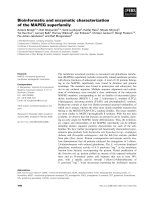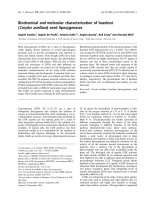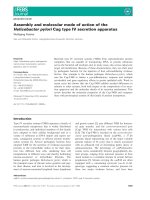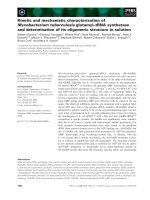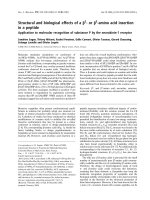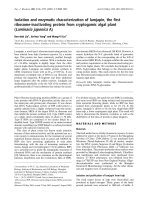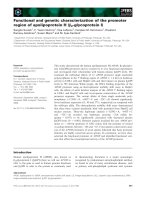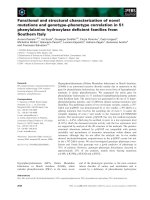Báo cáo khóa học: Biochemical and molecular characterization of a laccase from the edible straw mushroom, Volvariella volvacea docx
Bạn đang xem bản rút gọn của tài liệu. Xem và tải ngay bản đầy đủ của tài liệu tại đây (683.39 KB, 11 trang )
Biochemical and molecular characterization of a laccase
from the edible straw mushroom,
Volvariella volvacea
Shicheng Chen, Wei Ge and John A. Buswell
Department of Biology and the Centre for International Services to Mushroom Biotechnology, The Chinese University of Hong Kong,
Shatin, New Territories, Hong Kong SAR, China
We have isolated a laccase (lac1) from culture fluid of Vol-
variella volvacea, grown in a defined medium containing
150 l
M
CuSO
4
, by ion-exchange and gel filtration chroma-
tography. Lac1 has a molecular mass of 58 kDa as deter-
mined by SDS/PAGE and an isoelectric point of 3.7.
Degenerate primers based on the N-terminal sequence of
purified lac1 and a conserved copper-binding domain were
used to generate cDNA fragments encoding a portion of
the lac1 protein and RACE was used to obtain full-length
cDNA clones. The cDNA of lac1 contained an ORF of
1557 bp encoding 519 amino acids. The amino acid sequence
from Ala25 to Asp41 corresponded to the N-terminal
sequence of the purified protein. The first 24 amino acids are
presumed to be a signal peptide. The expression of lac1 is
regulated at the transcription level by copper and various
aromatic compounds. RT-PCR analysis of gene transcrip-
tion in fungal mycelia grown on rice-straw revealed that,
apart from during the early stages of substrate colonization,
lac1 was expressed at every stage of the mushroom devel-
opmental cycle defined in this study, although the levels
of transcription varied considerably depending upon the
developmental phase. Transcription of lac1 increased shar-
ply during the latter phase of substrate colonization and
reached maximum levels during the very early stages
(primordium formation, pinhead stage) of fruit body mor-
phogenesis. Gene expression then declined to 20–30% of
peak levels throughout the subsequent stages of sporophore
development.
Keywords: Volvariella volvacea; laccase; edible mushroom;
gene expression.
Volvariella volvacea, the edible straw mushroom, produces
multiple forms of laccase (benzenediol:oxygen oxidoreduc-
tase, EC 1.10.3.2) when grown in submerged culture on
defined media containing copper or various aromatic
compounds, or in solid-state systems representative of the
conditions used for industrial cultivation ([1]; S. Chen,
W. Ge and J. A. Buswell, unpublished results). Whereas, in
many other basidiomycetes enzyme biosynthesis is normally
associated with primary growth [2–5], laccase production in
V. volvacea has the relatively novel feature of occurring only
in the later stages of primary growth i.e., when fungal
biomass production has reached a maximum [1]. Further-
more, when the fungus is grown on cotton waste ÔcompostsÕ
[6], the very low levels of laccase observed throughout the
substrate colonization phase increase sharply at the onset of
fruit body initiation. This increase in laccase activity was
observed only in those composts that produced fully
developed sporophores [1].
Laccases have been assigned several different biological
roles. In higher plants, laccases are involved in lignification
of xylem tissues [7]. The enzyme has also been linked to
pigment biosynthesis during conidial development and
maturation in Aspergillus nidulans [8], the pathogenicity of
the chestnut blight fungus Cryphonectria parasitica [9] and
in the biosynthesis of cinnabarinic acid, a fungal metabolite
produced by Pycnoporus cinnabarinus that exhibits anti-
microbial activity against various bacterial species [10]. Of
particular importance to our own research are the assigned
roles of laccases in lignin degradation [11–13], in rendering
phenolic compounds less toxic via oxidative coupling and
polymerization [14] and in sporophore formation [15,16]. As
all these latter three functions are of fundamental import-
ance for the colonization of the various lignocellulosic
substrates used in mushroom cultivation systems and for
mushroom fruiting body development, we sought to learn
more about the laccase component(s) of V. volvacea. This
commercially important edible mushroom is grown and
consumed in many parts of Asia, and currently ranks fifth
among the major cultivated species in terms of annual
production worldwide [17].
Our earlier studies established that two laccase isoforms
were induced in submerged cultures of V. volvacea in
response to addition of copper or various aromatic com-
pounds to the culture medium [1]. In this study, we have
purified and characterized one of the laccase isoforms,
cloned and sequenced the cDNA encoding the enzyme
protein, and examined the effect of copper and various
Correspondence to J.A. Buswell, Edible Fungi Institute,
35 Nanhua Road, Shanghai 201106, China.
Fax: + 86 21 62207544, Tel.: + 86 21 62208660,
E-mail:
Abbreviations: lac1, laccase; 2,6-DMP, 2,6-dimethoxyphenol; HBT,
1-hydroxybenzotriazole; XYL, 2,5-xylidine; FA, ferulic acid.
Enzyme: benzenediol:oxygen oxidoreductase (EC 1.10.3.2).
(Received 26 August 2003, revised 5 November 2003,
accepted 18 November 2003)
Eur. J. Biochem. 271, 318–328 (2004) Ó FEBS 2003 doi:10.1046/j.1432-1033.2003.03930.x
aromatic compounds on gene expression. We have also
determined the transcription pattern for the laccase gene
in V. volvacea grown on paddy-straw throughout various
stages of the mushroom developmental cycle and detected
large increases in lac1 gene transcription late in the substrate
colonization phase and during the early stages of fruit body
morphogenesis. A good correlation existed between total
laccase activity and lac1 expression under these growth
conditions. A better understanding of the role(s) played
by individual laccase isoforms in sporophore development
should aid the development of strategies for improving
mushroom growth yields.
Experimental procedures
Organism and growth conditions
V. volvacea V14 was obtained from the culture collection
of the Centre for International Services to Mushroom
Biotechnology (accession no. CMB 002) [1].
The fungus was cultivated at 32 °C in stationary 250 mL
Erlenmeyer flasks containing 50 mL basal medium [18].
Nitrogen was added as NH
4
NO
3
and
L
-asparagine at
concentrations equivalent to 26 m
M
-N [19]. The effects of
ferulic acid (FA; Sigma, St Louis, MO, USA) on lac1
transcription were studied by growing the fungus on basal
medium without FA for 6 days before supplementing
cultures with different concentrations of FA as indicated.
Total RNA was extracted from mycelia after 24 h further
incubation. A basal medium prepared with a modified trace
element solution [18] lacking the Cu component (equivalent
to 1.5 l
M
Cu) was used to examine the effect of Cu on
laccase gene expression. The effect of different aromatic
compounds on laccase production was determined after 36 h
following supplementation of 6 day-old cultures with 2 m
M
(final concentration) of the test compound. For purification
of laccase 1 (lac1), the fungus was grown in 2 L flasks
containing 600 mL basal medium with 150 l
M
CuSO
4
.
Gene expression during the mushroom developmental
cycle was determined in rice-straw compost cultures
prepared as follows: 150 g rice-straw was soaked overnight
in 450 mL of distilled water. After draining off any
remaining free water, the straw was mixed with lime
(15 g) and wheat bran (15 g) and the material distributed
into cellophane bags and autoclaved at 121 °C for 30 min.
After cooling, the compost was inoculated with fungal
mycelium (from 2 week-old compost cultures) and incuba-
ted at 32 °C and 90–95% relative humidity. The bags were
removed after 14 days to promote fruiting. Samples were
taken from duplicate cultures at different stages of the
mushroom developmental cycle: early, middle and late
substrate colonization stages (4, 8 and 12 days); pinhead
stage (day 14), button stage (day 18), egg stage (day 21),
elongation stage (day 22) and mature stage (day 23).
After collection, compost material was stored immediately
at )70 °C prior to analysis.
Enzyme assay
Laccase activity was determined using 2,2¢-azinobis-(3-
ethylbenzo-6-thiazolinesulfonic acid) (ABTS) as described
previously [1,20].
Protein determination
Protein in culture supernatants was determined by the
method of Bradford [21] with bovine serum albumin as
standard, and in column effluents by measuring A
280
.
Purification of lac1
The following procedures were all performed at 4 °C.
Culture fluid obtained after filtration of 7-day cultures of
V. volvacea was centrifuged (10 000 g, 30 min) and con-
centrated 40-fold with the Pellicon ultrafiltration system
(Millipore) using a 10-kDa molecular mass cut-off mem-
brane. Solid ammonium sulfate was added and the fraction
precipitating at 80% saturation was collected by centrifu-
gation, redissolved in 20 mL 10 m
M
phosphate buffer,
pH 5.8, and dialysed overnight against two changes of fresh
buffer. Precipitated material was removed by centrifugation
(10 000 g, 30 min) and the supernatant was applied to a
column (2.5 · 20 cm) of DEAE/Sepharose pre-equilibrated
with the same buffer. After washing with 350 mL of 10 m
M
phosphate buffer, the enzyme was eluted with a linear
gradient of 0–1.0
M
NaCl in 500 mL of this buffer at a flow
rate of 0.5 mLÆmin
)1
. The active fractions ( 60 mL) were
pooled, concentrated to 10 mL by ultrafiltration using a
Centriprep YM-10 centrifugal filter (Millipore) and applied
to a Sephacryl-S300 column (1.5 · 90 cm) pre-equilibrated
with 10 m
M
potassium phosphate buffer, pH 6.5. The
enzyme was eluted with the same buffer at a flow rate of
0.5 mLÆmin
)1
and the combined active fractions ( 50 mL)
concentrated to 5 mL by ultrafiltration. This pooled
material was applied to a Sephacryl-S100 column (1.5 ·
90 cm) pre-equilibrated with 10 m
M
potassium phosphate
buffer, pH 6.5, and the enzyme was eluted with the same
buffer at a flow rate of 0.5 mLÆmin
)1
. Pooled active
fractions ( 30 mL) were concentrated with a Centriprep
YM-10 centrifugal filter (Millipore) and stored at )20 °C.
Enzyme characterization
The molecular mass of purified laccase was determined by
SDS/PAGE (15% w/v acrylamide gels) using low molecular
mass standards (Bio-Rad). The isoelectric point of the
enzyme was determined with the Phastsystem using Phast-
Gel IEF 3–9 operated for 410 Vh and standard pI markers
(Pharmacia). The standard assay conducted in 0.1
M
NaAc
buffer (pH 5.0) over the range 30–65 °Cwasusedto
determine the optimal temperature, and the optimal pH was
established using 0.1
M
Na
2
HPO
4
-citrate (pH 2.2–7.0) and
0.1
M
acetate (pH 4.0–7.0) buffer systems. Substrate speci-
ficity of purified lac1 was determined spectrophotometri-
cally in sodium citrate buffer (0.1
M
,pH5.0)usingthe
specific wavelength of each substrate. Michaelis–Menten
constants for ABTS, 2,6-dimethoxyphenol (2,6-DMP) and
syringaldazine were determined from Lineweaver–Burk
plots of data obtained by measuring the reaction rate under
optimal conditions using substrate concentration ranges of
0.005–1
M
, 0.01–1
M
and 0.0025–0.025
M
, respectively. The
effect of putative laccase inhibitors was determined in
standard assay reaction mixtures following incubation of
lac1 with individual inhibitors (0.1 m
M
or 1.0 m
M
in sodium
citrate buffer, pH 5) at 32 °Cfor5min.
Ó FEBS 2003 Laccase gene from Volvariella volvacea (Eur. J. Biochem. 271) 319
N-terminal sequencing of laccase
The N-terminal amino acid sequence of purified laccase was
determined by electroblotting the enzyme on to an Immo-
bilon poly(vinylidene difluoride) (PVDF) Millipore mem-
brane (LKB Multiblot apparatus, Bio-Rad) followed by
Edman degradation performed with a Hewlett-Packard
G1005A Protein Sequencer coupled to a HPLC (Hewlett-
Packard, Model 1090) for analysis of the phenylthiodantoin
amino acids.
RNA manipulations, cDNA synthesis and cloning
Mycelium from V. volvacea cultures grown for 12 days in
defined medium with 200 l
M
copper was harvested, frozen
with liquid nitrogen and ground to a fine powder with a
mortar and pestle. Total RNA was isolated from this
material using the Tri-Reagent (Molecular Research Center,
Inc. Cincinnati, OH, USA) and used to synthesize cDNA.
Reverse transcription was carried out at 42 °Cfor2hina
10-lL reaction volume containing: 2 lL diethylpyrocarbo-
nate-treated H
2
O, 2 lL5· First Strand Buffer (Gibco
Invitrogen), 0.01
M
dithiothreitol, 0.5 m
M
dNTPs, 0.5 lg
oligo(dT), 2 lg total RNA and 100 U SuperScript II (Gibco
Invitrogen). The cDNA from the reaction was kept at
)70 °C and used for PCR amplification using degenerate
primers designed on part of the N-terminal amino acid
sequence and a conserved copper-binding region. The
sequences and primers were: primer 1 (upper primer):
5¢-(CT)T(AGCT)AC(AGCT)AA(CT)GG(AGCT)TT(CT)
GC-3¢ (encoding LTNGFA); primer 2 (lower antisense
primer): 5¢-(AG)(AG)TG(AGCT)(GC)(AT)(AG)TG(AG)
TACCA(AG)AA-3¢ (encoding FWYHSHL). Different
primers were designed with any one of the bases shown in
parentheses.
PCR amplification of the cDNA fragment encoding a
portion of lac1 was carried out using a PTC-100 (MJ
Research, Watertown, MA, USA) in 50 lL reaction
volumes containing 1.25 U Taq DNA polymerase, 5 lL
10· Mg-free reaction buffer, 200 l
M
dNTP, 2.5 m
M
MgCl
2
,
1 l
M
primer1orprimer2and0.5lL template. Amplifi-
cation conditions were: 1 cycle of 94 °Cfor3min,50 °Cfor
30 s and 72 °C for 1 min; 30 cycles of 94 °C for 30 s, 54 °C
for 30 s, and 72 °C for 1 min; then a final extension at 72 °C
for 10 min before storage at 4 °C. Amplification products
were fractionated by electrophoresis in 2.0% agarose/Tris
borate/EDTA gels and appropriate bands excised and
purified from the gel using the NucleoTrap Gel Extraction
Kit (Clontech). The purified DNA was precipitated with
ethanol and resuspended in 10 lLH
2
O. An aliquot (4 lL)
was incubated at 4 °C overnight with 3 U T4 DNA ligase
(Promega), 1 lL10· buffer with 10 m
M
ATP (Promega)
and 1 lL pGEM T-vector in a total volume of 10 lLand
transformed into E.coli DH5a. Plasmids encoding the lac1
fragment were isolated using the Wizard Miniprep Kit
(Promega) and sequenced by the dideoxy chain-termination
method using an automated ABI310 sequencer (Perkin
Elmer) according to the manufacturer’s instructions.
RACE was performed with the SMART RACE cDNA
Amplification Kit (Clontech) to obtain full-length cDNA
clones. Using the 309-bp fragment sequence of lac1
obtained above, the gene-specific primer (5¢-GGCACT
GAGTGACGAAGGCAGGACCATC-3¢), was designed
for the 5¢-RACE reaction to generate the 5¢-cDNA end
fragment of lac1.The5¢-cDNA end fragment was cloned
into pGEM T-vector and sequenced as above. The full-
length cDNA of lac1 was then generated by 3¢-RACE
using the primer 5¢-TCTCAACCGTCGACAGCAG
TGTTCGTG-3¢ designed from the sequence of the extreme
5¢ end of lac1. The full-length cDNA of lac1 was cloned and
sequenced as above.
RT-PCR for semiquantification of the
lac1
expression
levels
Total RNA extracted from liquid cultures and mRNA
extracted from compost cultures using the polyA TRACT
mRNA isolation system II kit (Promega), was reverse
transcribed into cDNA at 42 °C for 1 h in a total volume of
10 lL reaction solution containing 1 lgtotalRNAor
30 ng mRNA, 1 · First Strand Buffer, 10 m
M
dithiothrei-
tol, 0.5 m
M
each dNTP, 0.5 lg oligo-dT and 100 U
SuperScript II (Gibco Invitrogen). PCR was performed in
a volume of 25 lL consisting of PCR buffer, 0.2 m
M
each
dNTP, 2.5 m
M
MgCl
2
,0.2l
M
each primer, and 0.5 U of
Taq polymerase. One microlitre of RT reaction was used in
each PCR reaction.
As a control for RNA loading, a 330 bp fragment of the
V. volvacea, V14 glyceraldehyde-3-phosphate dehydro-
genase (gpd) gene was amplified with primers P
GPDF
(5¢-TAATGACGGCAAACTCGTGATC-3¢)andP
GPDR
(5¢-TGTATGACTTTGGCCAGAGGTG-3¢) (accession
number AY280633). The PCR cycle programme was:
94 °C for 2 min; 23 cycles of 94 °Cfor20s,52°Cfor20s
and 70 °C for 2 min; then a final extension at 72 °C
for 10 min. The primers for lac1 P
LAC1F
(5¢-AGCTTT
CATTCCCAGTGATTG-3¢)andP
LAC1R
(5¢-AACGAG
CTCAAGTACAAATGACT-3¢) were designed according
to our cloned cDNA (GenBank Accession No. AY249052).
The PCR cycle programme was: 94 °C for 2 min; 28 cycles of
94 °C for 20 s, 52 °C for 20 s and 70 °C for 2 min; then a final
extension at 72 °C for 10 min. To validate the semiquanti-
tative RT-PCR reactions, a series of RT-PCR reactions were
sampled at different cycles and analysed by electrophoresis
to ensure that product abundance was evaluated in the
exponential phase of the reaction (half of the maximum
product). To further validate the assays, the optimized cycle
number (23 and 28 for gpd and lac1, respectively) was used to
amplify serially diluted gpd and lac1 DNA templates. After
electrophoresis on 2% agarose gel, the PCR products were
stained with ethidium bromide and visualized in a
UV-transilluminator. The signal intensity was quantified
with the Gel-DOC 100 system using the
MOLECULAR
ANALYST SOFTWARE
(Bio-Rad). The specificity of PCR and
RT-PCR amplification was confirmed by cloning the
products into pGEM T-vector (Promega) followed by
sequencing.
Results
Purification of lac1
Lac1 was separated as a single peak by a final gel filtration
step using Sephacryl S-100 and shown to be homogeneous
320 S. Chen et al. (Eur. J. Biochem. 271) Ó FEBS 2003
by SDS/PAGE and by isoelectric focusing combined
with silver staining (data not shown). After a five-step
purification protocol, the specific activity of lac1 was
increased 14-fold with a 22% recovery yield (Table 1).
Enzyme characterization
The molecular mass of purified lac1 was estimated by SDS/
PAGE to be 58 kDa and the isoelectric point of the enzyme
was 3.7. In addition to ABTS, syringaldazine and 2,6-DMP
were also oxidized by lac1 ( 17% of the activity observed
with ABTS). Guaiacol, catechol and 2,6-DMP were poor
substrates for the enzyme (< 5% compared with ABTS)
and no activity was detected with tyrosine, FA,
L
-3,4-
dimethoxyphenol and dihydroxyphenylalanine (
L
-DOPA).
With ABTS as the substrate, lac1 displayed a pH optimum
of 3.0 corresponding to a specific activity of 13.5 UÆmg
protein
)1
. Corresponding pH optima and specific activities
for syringaldazine and 2,6-DMP were pH 5.6 and 3.4 UÆmg
protein
)1
and pH 4.6 and 2.8 UÆmg protein
)1
, respectively.
In standard assay mixtures, the velocity of ABTS oxidation
was maximal at 45 °C. The dependence of the rate of ABTS
oxidation by lac1 on substrate concentration at pH 3.0 and
45 °C followed Michaelis–Menten kinetics. A reciprocal
plot revealed an apparent K
m
value of 0.03 m
M
and a V
max
of 16.4ÆUmgprotein
)1
. Corresponding values for syring-
aldazine and 2,6-DMP under optimal conditions were
0.01 m
M
and 4.9 UÆmg protein
)1
, and 0.57 m
M
and
5.6 UÆmg protein
)1
, respectively. Lac1 is inhibited (100%)
by thioglycollic acid (1 m
M
), dithiothreitol (0.1 m
M
), azide
(0.1 m
M
) and cysteine (0.1 m
M
) but less so by 1 m
M
EDTA
(20%). The N-terminal sequence of native protein was
N-ALSSHTLTLTNGFASPD.
Cloning of full-length cDNA of
lac1
The cDNA contained a predicted ORF of 1557 bp encoding
519 amino acids (Fig. 1). The amino acid sequence from
Ala25 to Asp41 corresponded to the N-terminal sequence of
the purifiedprotein,andtheputativepresequenceof 24amino
acids is a hydrophobic signal peptide as predicted by the
computer program
PLOT
.
AHYD
using themethoddescribedby
Kyte and Doolittle [22]. The remaining 495 amino acids are
considered to constitute the lac1 mature protein giving a
calculated molecular mass of 53 212 Da. Two putative
polyadenylation signals (TATAAA and CATAAA) were
identified near the 3¢-end, suggesting possible differential
splicing over the 3¢-untranslated region after transcription.
Alignment of the deduced amino acid sequence of lac1
with deduced amino acid sequences of other fungal laccases
showed highest overall identity with laccase 1 (BAB84354)
from Lentinula edodes (58%), laccase (AF170093) from
Pycnoporus cinnabarinus (57%), laccase LCC3-1
(AF176230) from Polyporus ciliatus (56%) and laccase 1
(AAC498287) from Trametes versicolor (56%) (Fig. 2). The
lac1 protein contains only one potential N-glycosylation site
(Asn-X-Thr/Ser in which X is not proline). The calculated
isoelectric point for the cloned cDNA product is 4.5. All the
amino acid residues that serve as Cu
2+
ligands (10 His
residues and one Cys residue) are present in the lac1 coding
sequence (Fig. 2).
Validation of semiquantitative RT-PCR assay for
lac1
and
gpd
A series of RT-PCR reactions for lac1 (Fig. 3: left panel)
and gpd were performed at different cycles and analysed by
electrophoresis. Using the cycle number that generated the
half-maximal PCR amplification, PCR reactions were
performed on serially diluted lac1 and gpd template DNA.
A clear linear relationship between the amount of template
inputs and PCR amplification was obtained for both lac1
(Fig. 3: right panel) and gpd (data not shown) demonstra-
ting the workability of the RT-PCR assay for quantitating
lac1 mRNA levels.
Regulation of
lac1
expression by copper
The effect of copper concentration on lac1 expression in
cultures of V. volvacea isshowninFig.4.Lac1 transcrip-
tion increased with increasing concentrations of CuSO
4
in
the culture medium up to 200 l
M
. Higher copper concen-
trations were inhibitory and approximately 70% fewer
transcripts were observed in hyphae grown in the presence
of 300 l
M
copper sulfate. No lac1 transcripts were detected
in fungal cells grown in the absence of copper. A constant
level of control gpd fragment amplification was observed in
each reaction thereby confirming the uniform efficiency of
PCR amplification of RT reaction products. In time-course
experiments, transcripts of lac1 were detected in fungal
hyphae after 6 days growth in cultures supplemented with
200 l
M
copper sulfate and reached peak levels after 14 days
(data not shown).
Regulation of
lac1
expression by aromatic compounds
Laccase induction in V. volvacea by various aromatic
compounds occurred at the level of gene transcription.
Figure 5 shows the effect of different aromatic compounds
on lac1 expression in V. volvacea growninnitrogen-
Table 1. Summary of the purification procedure for V. volvacea lac1.
Volume
(ml)
Total
activity (IU)
Protein
(mg)
Specific
activity (IUÆmg
)1
)
Yield
(%)
Purification
fold
Crude enzyme 2000 32.6 25 1.3 100 1
Ultra filtration 50 30.6 20 1.4 94 1.1
(NH
4
)
2
SO
4
20 25 7 3.6 77 2.8
DEAE CL-6B 60 11.9 1 11.9 37 9.2
Sephacryl S-300 50 9 0.7 13 30 10
Sephacryl S-100 30 8.6 0.5 17.2 22 14
Ó FEBS 2003 Laccase gene from Volvariella volvacea (Eur. J. Biochem. 271) 321
Fig. 1. Nucleotide and deduced amino acid sequences of V. volvac ea lac1. Dashed underline, signal peptide; solid line, N-terminal sequence; double
solid line, amino acid sequences used to design degenerate primers. The putative N-glycosylation site is boxed; *; stop codon. The putative
polyadenylation signals (TATAAA and CATAAA) are in white on a black background.
322 S. Chen et al. (Eur. J. Biochem. 271) Ó FEBS 2003
sufficient medium without copper. Highest levels of gene
transcription were seen with FA, veratric acid, 4-hydroxy-
benzoic acid and 2,5-xylidine (XYL). Amounts of lac1
mRNA in the cultures increased with increasing concentra-
tions of FA (1–10 m
M
) although transcript levels in
mycelium grown with 5 m
M
and 10 m
M
of the aromatic
compound were not significantly different (data not shown).
No transcription was detectable in controls without added
FA.
Transcriptional regulation of
lac1
during growth
and fruiting of
V. volvacea
on straw
The duration of the developmental cycle of V. volvacea when
the mushroom was grown on rice-straw ÔcompostsÕ was
approximately 23 days. For the purpose of this study, eight
separate stages were identified as follows: half-colonization
of substrate (day 4), full-colonization (day 8), formation of
primordia (day 12), appearance of pinheads (day 14), button
stage (day 18), egg stage (day 21), elongation stage (day 22),
and mature fruiting body (day 23). The results of RT-PCR
analysis of gene transcription in fungal mycelia grown on
rice-straw and analysed at various stages of the developmen-
tal cycle are shown in Fig. 6A. No transcripts were detected
in the early stages of substrate colonization and lac1 was first
expressed only when substrate colonization was virtually
complete. A large increase in the number of transcripts was
seen at the stage of primordia formation and transcription
levels were still high when pinheads appeared. Transcription
levels declined at the button stage and then remained
relatively stable throughout the remaining stages of fruiting
body development. Approximately 70–80% fewer tran-
scripts were detected throughout these stages compared with
peak levels observed in the initial stages of sporophore
formation. Extracellular laccase activity in the same compost
samples are shown in Fig. 6B.
Fig. 2. Alignment of deduced amino acid sequences of lac1 and other fungal laccases. *, Amino acid conserved among all of the sequences. Ten His
residues and one Cys residue represent the amino acids that serve as Cu
2+
ligands and are shown in white on a black background.
Ó FEBS 2003 Laccase gene from Volvariella volvacea (Eur. J. Biochem. 271) 323
Discussion
Basidiomycetes typically produce multiple laccase isoforms
[5,23–29] and V. volvacea produces at least two protein
bands with laccase activity when grown in submerged
culture under different conditions [1]. Previous physiological
studies have shown that, as in other basidiomycetes, laccase
production by V. volvacea is induced by copper and by
various aromatic compounds. However, unlike most other
basidiomycetes, enzyme activity can be detected in the
extracellular culture fluids of V. volvacea only during the
latter stages of primary growth. In order to better under-
stand these effects at the molecular level, we have now
purified and characterized one of these laccases, lac1, and
cloned and sequenced the cDNA encoding the protein.
RT-PCRwasusedtostudytheregulationoflac1 gene
expression in V. volvacea when the fungus was grown in
submerged culture in the presence of known laccase
inducers, and in solid-state systems representing conditions
used for industrial cultivation. To our knowledge, this
Fig. 3. Validation of semiquantitative RT-
PCR assays for lac1. Left panel: Kinetics of
PCR amplification with the electrophoretic
image shown at the top. The cycle number
(28·) that generates half maximal reaction was
used to analyse the expression of the gene.
Right panel: PCR amplification of the cloned
lac1 cDNA using the cycle number obtained
from the left panel. Each value represents the
mean ± SD of three PCR reactions.
Fig. 4. RT-PCR analysis of transcription patterns of lac1 induced by
different concentrations of copper. Total RNA was isolated from
V. volvacea, V14, grown in defined medium with various concentra-
tions of copper sulfate. PCR products were electrophoresed in a 2%
agarose gel and stained with ethidium bromide. The expression levels
were normalized by using the relative mRNA ratio (lac1/gpd).
Fig. 5. RT-PCR analysis of total RNA isolated from V. volvacea,V14,
grown in defined medium supplemented with 2 m
M
aromatic compounds.
Fungal mycelia were cultured for 6 days prior to addition of aromatic
compound and harvested after a further 36 h incubation. PCR pro-
ducts were electrophoresed in a 2% agarose gel and stained with
ethidium bromide. The expression levels were normalized by using
the relative mRNA ratio (lac1/gpd). A, Vanillic acid; B, syringic acid;
C, 4-hydroxybenzoic acid; D, veratric acid; E, 4-hydroxybenzaldehyde;
F, ferulic acid; G, 3,4,5-trimethoxybenzoic acid; H, 2,5-xylidine;
I, vanillin; J, 3,4-dimethoxybenzaldehyde; K, 3,4-dimethoxybenzyl
alcohol; L, p-coumaric acid.
324 S. Chen et al. (Eur. J. Biochem. 271) Ó FEBS 2003
represents the first report on the cloning of a laccase gene
and the factors affecting its transcription in this economi-
cally important mushroom.
The purified lac1 protein is unusual in itself in that
concentrated solutions lack the typical blue colour and the
spectral maxima near 600 nm that characterize all the blue
oxidases. Furthermore, guaiacol is a poor substrate for the
enzyme. In both cases, lac1 resembles the ÔwhiteÕ laccase
(POXA1), isolated earlier from Pleurotus ostreatus [30] and
the laccase produced by Phellinus ribis [31]. Furthermore,
the N-terminal sequence of the lac1 protein exhibits very
low homology with sequences of other basidiomycete
laccases (Fig. 7).
Although the spectral characteristics of the lac1 protein
suggest the absence of a type 1 copper site, this is not borne
out by analysis of the deduced amino acid sequence of the
enzyme. Thus, the 10 histidines and one cysteine residue
required to coordinate the four copper atoms at the active
site of the enzyme [32] were all conserved in the V. volvacea
gene (Fig. 4). It is possible that depletion of type 1 copper
may have occurred during purification. However, attempts
to reconstitute the copper to the purified enzyme were
unsuccessful. Laccases also have an additional residue
involved in the coordination of type 1 copper atoms, located
10 residues downstream of the single cysteine. This residue,
which appears to have a role in determining the redox
potential of the enzyme [33], can be methionine, leucine or
phenylalanine. Therefore, lac1 with a leucine residue at
position 458 should be assigned to class 2 according to the
categorization proposed by Eggert et al. [34]. Other class 2
enzymes include laccases from the basidiomycetes, Agaricus
bisporus [27], Podospora anserina [35], Phlebia radiata [36],
the ascomycetous fungi, G. graminis [23], Neurospora crassa
[37], Cryphonectria parasitica [9] and the yeast, Cryptococcus
neoformans [38]. Two laccase genes described in Lentinula
edodes also have a leucine residue in the analogous
downstream position. However, the cysteine residue
believed to be critical for coordination of the copper atoms
is apparently not conserved in these genes and is replaced by
tryptophan [39].
Although V. volvacea produces at least two laccase
isoforms [1], the primers used in this study appear to be
specific for lac1 as in every case, only one band was
amplified from each of the different samples and
Southern blot analysis using the probe prepared with
the lac1 primers also revealed a single band. Further-
more, all of these generated PCR products were found to
comprise of sequences identical to those present in the
lac1 cDNA.
Copper regulates lac1 transcription in V. volvacea and
the correlation between copper concentration and lac1
transcription corresponds well with previously observed
effects of copper on total extracellular laccase activity in
copper-supplemented cultures of V. volvacea [1]. A similar
regulatory role for copper has been proposed for some
laccase genes in several other basidiomycete fungi including
Pleurotus spp. [5,26,40,41]., Trametes spp. [2,42]., Podos-
pora anserina [35] and Ceriporiopsis subvermispora [43]. In
P. ostreatus, copper not only regulated laccase gene
expression but also positively affected the activity and
stability of the enzyme [40]. The effect of copper on
enzyme stability may be related to the inhibitory effect of
the metal on the activity of an extracellular protease
produced by P. ostreatus (PoSl) that is reported to degrade
laccase [44].
Copper does not appear to be essential for the activation
of lac1 transcription in V. volvacea as several aromatic
compounds also induce gene transcription in copper-
deficient cultures. Stimulation of laccase production by
Fig. 6. Transcription analysis of lac1 by RT-PCR (A) and total laccase
activity (B) during various stages of V. volvacea fruitbody development.
mRNA was extracted from the mycelium harvested at the following
stages: substrate colonization stages (4, 8, 12 days), pinhead (day 14),
button stage (day 18), egg stage (day 21), elongation stage (day 22) and
mature stage (day 23). The expression levels were normalized by using
the relative mRNA ratio (lac1/gpd). Extracellular protein was extrac-
ted from rice-straw composts by suspending the substrate in 50 m
M
KHPO
4
buffer (pH 6.5) and shaking (150 r.p.m.) for 2 h at room
temperature.
Ó FEBS 2003 Laccase gene from Volvariella volvacea (Eur. J. Biochem. 271) 325
aromatics is well-documented and has led to the suggestion
that one role of the enzyme is as a defence mechanism
against oxidative stress caused by oxygen radicals origin-
ating from aromatic compounds [14,45]. However, wide
variations are seen with respect to the induction of laccase
gene transcription by aromatic compounds with both
inducible and noninducible forms described [46], suggesting
that only certain isoenzymes serve in a protective capacity.
Transcription of one laccase gene, lcc1,fromTrametes
villosa was induced 17-fold by the addition of XYL but a
second gene (lcc2) was constituitive under the conditions
tested [29]. Amounts of laccase mRNA and laccase activity
in 10-day-old cultures of T. versicolor were a direct function
of concentrations of the laccase inducers, 1-hydroxybenzo-
triazole (HBT) and XYL but no induction was observed
after the addition of FA and veratric acid (VA) [2]. Two
laccase genes, lcc1 and lcc2 present in an unidentified
basidiomycete I-62 were both inducible by veratryl alcohol
but at different stages of growth, whereas transcriptional
levels of a third gene, lcc3, were unaffected [24]. HBT, XYL,
FA and VA all induced extracellular laccase production in
P. sajor-caju and transcription levels of three laccase genes
were increased by FA and XYL [5]. Higher levels of laccase
mRNA were also reported in cultures of three white-rot
fungi supplemented with aromatic compounds [47]. Tran-
scription of only one of two laccase genes in T. versicolor
was induced by 2,5-dimethylaniline [30]. Several aromatic
compounds increase transcription of V. volvacea lac1 to
varying degrees. FA was the most effective inducer of
transcription and correspondingly high levels of extracellu-
lar laccase activity were observed in cultures supplemented
with this aromatic compound [1]. Ferulic acid is toxic to
V. volvacea and radial mycelial growth on agar plates
containing 1, 5 and 10 m
M
FA is inhibited by 37.6%, 71.8%
and 100%, respectively (data not shown) suggesting that
induction of this laccase isoform may in part, at least, be a
detoxification response.
Both laccase activity and lac1 gene transcription in
compost cultures of V. volvacea were detected late in the
substrate colonization phase when a sharp increase in both
parameters was recorded (Fig. 6A,B). There was also
good correlation between total laccase activity and lac1
expression although, as V. volvacea produces at least one
other laccase isoform in addition to lac1 [1], this and
possibly other laccase isoforms may be contributing to the
total laccase activity detected at the various developmental
stages. The pattern of laccase gene expression observed in
compost grown cultures of V. volvacea contrasts sharply
with activity profiles reported for other mushroom species.
In straw cultures of Pleurotus cornucopiae var. citrinopile-
atus, laccase activity was maximal during the vegetative
growth and declined rapidly at the onset of fruiting [48].
Laccase activity in cultures of A. bisporus grown under
standard composting conditions increased in the compost
until just after the ÔpinningÕ stage (height of sporophores,
1.0 cm) of development and was correlated strongly with
the loss of lignin from the compost [49]. Enzyme activity
then declined rapidly during the later stages of fruit body
development [16,50,51], decreasing by 87% in the 7 days
between the appearance of the first fruit body initials and
fruit body maturation [50]. Moreover, laccase gene expres-
sion measured as mRNA levels was maximal at the fully
colonized stage prior to fruiting and then declined to very
low levels during fruiting [52]. Similarly, the activity of
laccase was regulated strongly during the development of
L. edodes fruit bodies [53,54]. Laccase gene expression
(measured as mRNA levels) during growth of the fungus on
a sawdust-based substrate was maximal at the fully
colonized stage prior to fruiting and declined to very low
levels during fruiting [53,54].
While the higher levels of laccase gene expression
observed during vegetative growth of A. bisporus and
L. edodes, together with supporting biochemical data,
indicate that laccases are involved directly in lignin biocon-
version by these fungi [49,53,54], such a function in
V. volvacea seems unlikely. Indeed, there is little evidence
showing that V. volvacea is actually capable of degrading
the lignin polymer and it has been suggested that an inability
to do so accounts for the relatively poor mushroom yields
achieved on lignified growth substrates [55]. Instead, the
appearance of extracellular laccase activity in submerged
cultures of V. volvacea at the onset of secondary metabolism
[1], the temporal correlation observed between laccase
production and sporophore formation when the mushroom
was grown on cotton waste ÔcompostsÕ which were virtually
devoid of any lignin component [1] and the pattern of lac1
transcription reported here, all provide strong evidence
indicating that at least one enzyme isoform plays a key role
in the morphogenesis of the V. volvacea fruit body. It has
been proposed that phenoloxidases such as laccase could
crosslink hyphal walls into coherent aggregates during
primordium initiation [56] and may continue to act on the
hyphal surfaces throughout fruit body development [57].
Further studies on a possible link between laccase and
sporophore development in V. volvacea are underway as
part of our overall aim to develop strategies for improved
mushroom production through the control of fruit body
growth, flush yield and flush timing [52].
Fig. 7. Comparison of N-terminal sequences of various fungal laccases.
326 S. Chen et al. (Eur. J. Biochem. 271) Ó FEBS 2003
Acknowledgements
This work was supported by a grant from the Hong Kong Research
Grants Council (grant CUHK 4163/01 M). We thank Dr Shao-jun
Ding for providing the solid-state samples for transcriptional analysis.
References
1. Chen, S.C., Ma, D., Ge, W. & Buswell, J.A. (2003) Induction of
laccase activity in the edible straw mushroom, Volvariella volvacea.
FEMS Microbiol. Lett. 218, 143–148.
2. Collins, P.J. & Dobson, A.D.W. (1997) Regulation of laccase gene
transcription in Trametes versicolor. Appl. Environ. Microbiol. 63,
3444–3450.
3. Eggert, C., Temp, U. & Eriksson, K E. (1996) The ligninolytic
system of the white rot fungus Pycnoporus cinnabarinus:purifica-
tion and characterization of the laccase. Appl. Environ. Microbiol.
62, 1151–1158.
4. Fu, S.Y., Yu, H S. & Buswell, J.A. (1997) Effect of nutrient
nitrogen and manganese on manganese peroxidase and laccase
production by Pleurotus sajor-caju. FEMS Microbiol. Lett. 147,
133–137.
5. Soden, D.M. & Dobson, A.D.W. (2001) Differential regulation of
laccase gene expression in Pleurotus sajor-caju. Microbiol. 147,
1755–1763.
6. Chang, S.T. (1974) Production of the straw mushroom (Volvari-
ella volvacea) from cotton wastes. Mushroom J. 503, 348–354.
7. LaFayette, P.R., Eriksson, K E. & Dean, J.F.D. (1999) Char-
acterization and heterologous expression of laccase cDNA from
xylem tissues of yellow-poplar (Liriodendron tulipifera). Plant Mol.
Biol. 40, 23–35.
8. Tsai, H.F., Wheeler, M.H., Chang, Y.C. & Kwon, C.K.J. (1999)
A developmentally regulated gene cluster involved in conidial
pigment biosynthesis in Aspergillus fumigatus. J. Bacteriol. 181,
6469–6477.
9. Choi, G.H., Larson, T.G. & Nuss, D.L. (1992) Molecular analysis
of the laccase gene from the chestnut blight fungus and selective
suppression of its expression in an isogenic hypovirulent strain.
Mol. Plant Microbe Interact. 5, 119–128.
10. Eggert, C. (1997) Laccase-catalyzed formation of cinnabarinic
acid responsible for antibacterial activity of Pycnoporus cinna-
barinus. Microbiol. Res. 152, 315–318.
11. Archibald, F. & Roy, B. (1992) Production of manganic chelates
by laccase from the lignin degrading fungus. Trametes (Coriolus)
versicolor. Appl. Environ. Microbiol. 58, 1496–1499.
12. Ardon, O., Kerem, Z. & Hadar, Y. (1998) Enhancement of lignin
degradation and laccase activity in Pleurotus ostreatus by cotton
stalk extract. Can. J. Microbiol. 44, 676–680.
13. Eggert, C., Temp, U. & Eriksson, K E. (1997) Laccase is essential
for lignin degradation by the white rot fungus Pycnoporus cinna-
barinus. FEBS Lett. 407, 89–92.
14. Bollag, J M., Shuttleworth, K.L. & Anderson, D.H. (1988)
Laccase-mediated detoxification of phenolic compounds. Appl.
Environ. Microbiol. 54, 3086–3091.
15. De Vries, O.M.H., Koolstra, W.H.C.F. & Wessels, G.H. (1986)
FormationofanextracellularlaccasebySchizophyllum commune
Dikaryon. J. Gen. Microbiol. 132, 2817–2826.
16. Wood, D.A. (1980) Inactivation of extracellular laccase during
fruiting of Agaricus bisporus. J. Gen. Microbiol. 117, 339–345.
17. Chang, S.T. (1999) World production of cultivated edible and
medicinal mushrooms in 1997 with particular emphasis on Len-
tinula edodes (Berk.) Sing. in China. Int. J. Med. Mushrooms 1,
291–300.
18. Cai, Y.J., Chapman, S.J., Buswell, J.A. & Chang, S.T. (1999)
Production and distribution of endoglucanase, cellobiohydrolase,
and b-glucosidase components of the cellulolytic system of Vol-
variella volvacea, the edible straw mushroom. Appl. Environ.
Microbiol. 65, 553–559.
19. Buswell, J.A., Mollet, B. & Odier, E. (1984) Ligninolytic enzyme
production by Phanerochaete chrysosporium under conditions of
nitrogen sufficiency. FEMS Microbiol. Lett. 25, 295–299.
20. Bourbonnais, R. & Paice, M.G. (1988) Veratryl alcohol oxidases
from the lignin-degrading basidiomycete Pleurotus sajor-caju.
Biochem. J. 255, 445–450.
21. Bradford, M.M. (1976) A rapid and sensitive method for detecting
microgram amounts of protein utilizing the principle of protein-
dye binding. Anal. Biochem. 72, 248–254.
22. Kyte, J. & Doolittle, R.F. (1982) A simple method for displaying
the hydropathic character of a protein. J. Mol. Biol. 157, 105–132.
23. Litvintseva, A.P. & Henson, J.M. (2002) Cloning, characteriza-
tion, and transcription of three laccase genes from Gaeumanno-
myces graminis var. tritici, the take-all fungus. Appl. Environ.
Microbiol. 68, 1305–1311.
24. Mansur, M., Suarez, T. & Gonzalez, A.E. (1998) Differential gene
expression in the laccase gene family from basidiomycete I-62
(CECT 20197). Appl. Environ. Microbiol. 64, 771–774.
25. Ong, E., Pollock, W.B. & Smith, M. (1997) Cloning and
sequence analysis of two laccase complementary DNAs from
the ligninolytic basidiomycete Trametes versicolor. Gene 196, 113–
119.
26. Palmieri, G., Giardina, P., Bianco, C., Fontanella, B. & Sannia,
G. (2000) Copper induction of laccase isoenzymes in the lig-
ninolytic fungus Pleurotus ostreatus. Appl. Environ. Microbiol. 66,
920–924.
27. Perry, C.R., Smith, M., Britnell, C.H., Wood, D.A. & Thurston,
C.F. (1993) Identification of two laccase genes in the cultivated
mushroom Agaricus bisporus. J. Gen. Microbiol. 139, 1209–1218.
28. Srinivasan, C., D’Souza, T.M., Boominathan, K. & Reddy, C.A.
(1995) Demonstration of laccase in the white rot basidiomy-
cete Phanerochaete chrysosporium BKM-F1767. Appl. Environ.
Microbiol. 61, 4274–4277.
29. Yaver, D.S., Xu, F., Golightly, E.J., Brown, K.M., Brown, S.H.,
Rey,M.W.,Schneider,P.,Halkier,T.,Mondorf,K.&Dalbøge,
H. (1996) Purification, characterization, molecular cloning, and
expression of two laccase genes from the white rot basidiomycete
Trametes villosa. Appl. Environ. Microbiol. 62, 834–841.
30. Palmieri, G., Giardina, P., Bianco, C., Scaloni, A., Capasso, A. &
Sannia, G. (1997) A novel white laccase from Pleurotus ostreatus.
J. Biol. Chem. 272, 31301–31307.
31. Min, K L., Kim, Y H., Kim, Y.W., Jung, H.S. & Hah, Y.C.
(2001) Characterization of a novel laccase produced by the
wood-rotting fungus Phellinus ribis. Arch. Biochem. Biophys. 392,
279–286.
32. Messerschmidt, A. & Huber, R. (1990) The blue oxidases, ascor-
bate oxidase, laccase and ceruloplasmin. Modelling and structural
relationships. Eur. J. Biochem. 187, 341–352.
33. Canters, G.W. & Gilardi, G. (1993) Engineering type-1 copper
sites in proteins. FEBS Lett. 325, 39–48.
34. Eggert, C., Lafayette, P.R., Temp, U., Eriksson, K E. & Dean,
J.F.D. (1998) Molecular analysis of a laccase gene from the white
rot fungus Pycnoporus cinnabarinus. Appl. Environ. Microbiol. 64,
1766–1772.
35. Fernadez-Larrea, J. & Stahl, U. (1996) Isolation and character-
ization of a laccase gene from Podospora anserina. Mol. Gen.
Genet. 252, 539–551.
36. Saloheimo, M., Niku-Paavola, M L. & Knowles, J.K.C. (1991)
Isolation and structural analysis of the laccase gene from the lig-
nin-degrading fungus Phlebia radiata. J. Gen. Microbiol. 137,
1537–1544.
37. Germann, U.A., Muller, G., Hunziker, P.E. & Lerch, K. (1988)
Characterization of two allelic forms of Neurospora crassa laccase.
J. Biol. Chem. 263, 885–896.
Ó FEBS 2003 Laccase gene from Volvariella volvacea (Eur. J. Biochem. 271) 327
38. Williamson, P.R. (1994) Biochemical and molecular characteri-
zation of the diphenol oxidase of Cryptococcus neoformans:iden-
tification as a laccase. J. Bacteriol. 176, 656–664.
39. Zhao, J. & Kwan, H.S. (1999) Characterization, molecular clon-
ing, and differential expression analysis of laccase genes from the
edible mushroom Lentinula edodes. Appl. Environ. Microbiol. 65,
4908–4913.
40. Baldrian, P. & Gabriel, J. (2002) Copper and cadmium increase
laccase activity in Pleurotus ostreatus. FEMS Microbiol. Lett. 206,
69–74.
41. Mun
˜
oz, C., Guille
´
n, F., Martı
´
nez, A.T. & Martı
´
nez, M.J. (1997)
Induction and characterization of laccase in the ligninolytic fungus
Pleurotus eryngii. Curr. Microbiol. 34, 1–5.
42. Galhaup, C., Goller, S., Peterbauer, C.K., Strauss, J. & Haltrich,
D. (2002) Characterization of the major laccase isoenzyme from
Trametes pubescens and regulation of its synthesis by metal ions.
Microbiology 148, 2159–2169.
43. Karahanian, E., Corsini, G., Lobos, S. & Vicun
˜
a, R. (1998)
Structure and expression of a laccase gene from the ligninolytic
basidiomycete Ceriporiopsis subvermispora. Biochim. Biophys.
Acta 1443, 65–74.
44. Palmieri, G., Bianco, C., Cennamo, G., Giardina, P., Marino, G.,
Monti, M. & Sannia, G. (2001) Purification, characterization, and
functional role of a novel extracellular protease from Pleurotus
ostreatus. Appl. Environ. Microbiol. 67, 2754–2759.
45. Imbert, J., Culotta, V., Fu
¨
rst, P., Gedamu, L. & Hammer, D.
(1990) Regulation of metallothionein gene transcription by metals.
In Metal-Ion Induced Regulation of Gene Expression. (Eichorn,
G.L & Marzilli, L.G, eds), Vol. 8, pp. 139–164. Elsevier Science
Publishing, Inc., New York.
46. Thurston, C.F. (1994) The structure and function of fungal lac-
cases. Microbiology 140, 19–26.
47. Bollag, J M. & Leonowicz, A. (1984) Comparative studies of
extracellular fungal laccases. Appl. Environ. Microbiol. 48, 849–854.
48. Scheel, T., Ho
¨
fer, M., Ludwig, S. & Ho
¨
lker, U. (2000) Differential
expression of manganese peroxidase and laccase in white-rot fungi
in the presence of manganese or aromatic compounds. Appl.
Microbiol. Biotechnol. 54, 686–691.
49. Kaviyarasan, V. & Natarajan, K. (1997) Changes in extracellular
enzyme activities during growth and fruiting of Pleurotus cornu-
copiae var. citrinopileatus.InAdvances in Mushroom Biology
and Production. (Rai,R.D.,Dhar,B.L.&Verma,R.N.,eds),
pp. 309–320. Mushroom Society of India, Solan, India.
50. Durrant, A.J., Wood, D.A. & Cain, R.B. (1991) Lignocellulose
biodegradation by Agaricus bisporus during solid state fermenta-
tion. J. Gen. Microbiol. 137, 751–755.
51. Bonnen, A.M., Anton, L.H. & Orth, A.B. (1994) Lignin-degrad-
ing enzymes of the commercial button mushroom, Agaricus bis-
porus. Appl. Environ. Microbiol. 60, 960–965.
52. Wood, D.A. & Goodenough, P.W. (1977) Fruiting of Agaricus
bisporus. Changes in extracellular enzyme activities during growth
and fruiting. Arch. Microbiol. 114, 161–165.
53. Ohga, S., Smith, M., Thurston, C.F. & Wood, D.A. (1999)
Transcriptional regulation of laccase and cellulase genes in the
mycelium of Agaricus bisporus during fruit body development on a
solid substrate. Mycol. Res. 103, 1557–1560.
54. Ohga, S. & Royse, D.J. (2001) Transcriptional regulation of lac-
case and cellulase genes during growth and fruiting of Lentinula
edodes on supplemented sawdust. FEMS Microbiol. Lett. 210,
111–115.
55. Ohga, S., Cho, N.S., Thurston, C.F. & Wood, D.A. (2000)
Transcriptional regulation of laccase and cellulase genes in
Lentinula edodes on a sawdust-based substrate. Mycoscience 41,
149–153.
56. Cai, Y.J., Buswell, J.A. & Chang, S.T. (1994) Production of cel-
lulases and hemicellulases by the straw mushroom, Volvariella
volvacea. Mycol. Res. 98, 1019–1024.
57. Bu’lock, J.D. (1967) Fungal metabolites with structural function.
In Essays in Biosynthesis and Microbial Development: E.R. Squibb
Lectures on Chemistry of Microbial Products, pp. 1–18. John
Wiley, New York.
58. Leatham, G.F. & Stahmann, M.A. (1981) Studies on the laccase
of Lentinus edodes: specificity, localization and association
with the development of fruiting bodies. J. Gen. Microbiol. 125,
147–157.
328 S. Chen et al. (Eur. J. Biochem. 271) Ó FEBS 2003

